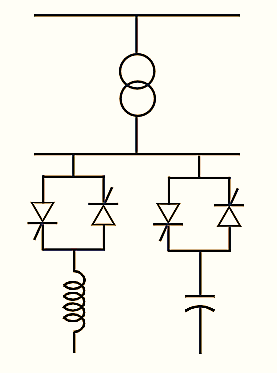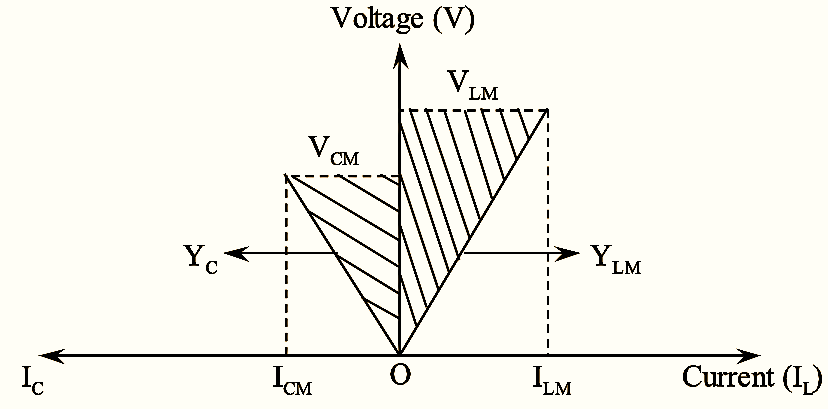A Static VAR Compensator (SVC) is a shunt connected static VAR generator or absorber in which control of certain power system parameters are achieved by exchanging the capacitive or inductive current which is possible by adjusting its output. SVC is a common name for a thyristor-controlled or thyristor-switched reactor, and/or thyristor-switched capacitor or combination.

Figure 1.
Design of SVC possesses thyristors without gate tum-off capability. Separate apparatus for leading and lagging VAR are incorporated in SVC. To absorb reactive power, thyristor-controlled or thyristor-switched reactors are used and to supply reactive power thyristor-switched capacitor is used. Figure 1 shows a basic model of SVC.
Fixed Capacitor-Thyristor Controlled Reactor (FC-TCR)

Figure 2.
As shown in figure (2), an FC-TCR consists of a fixed (permanently connected) capacitor with a thyristor controlled reactor. In this the method of firing delay angle control is employed to vary the current in the reactor. A filter network with required capacitive impedance usually replaces the fixed capacitor fully or partially at the fundamental frequency. This is done so as to generate the required reactive power. But at certain frequencies it provides a low impedance in order to avoid the dominating harmonics generated by TCR.
Characteristics:

The V-I characteristic of Fixed Capacitor-Thyristor Controlled Reactor is defined by maximum admittance of inductor and capacitor and by their voltage and current rating. The VI characteristic of FC-TCR is shown in below figure (2),
Where,
ICM = Maximum capacitive current
ILM = Maximum inductive current
VCM = Maximum capacitor voltage
VLM = Maximum TCR voltage
YC = Capacitor admittance
YLM = Maximum Inductor admittance.
Advantages of Static VAR Compensator (SVC)
- SVC is simple in operation.
- It improves the steady state and transient stability
- It has higher voltage capacity
- It gives faster and reliable response.
- It is less expensive.
Applications of Static VAR Compensator (SVC)
- SVCs are employed in long transmission lines to increase the power transfer capability.
- These VAR compensators are also employed at sub transmission and distribution system levels for balancing the three individual phases of the system supplying unbalanced loads.
- Fluctuations in the supply voltage can be minimized by employing static var compensators.
- Control of dynamic over voltage is also possible.
Difference between SVC and STATCOM
|
SVC |
STATCOM |
| SVC functions as a shunt connected, controlled reactive admittance. | STATCOM operates as a shunt connected, synchronous voltage source. |
| Harmonics generated are more. | Harmonics generated are less. |
| Slow performance during transient state. | Comparatively better performance during transient state and the response is faster. |
| Region of operation is mainly capacitive region. | Possible regions of operations include both inductive and capacitive regions. |
| Transmission system harmonic resonance affects the operation of SVC. | Transmission system harmonic resonance does not affect the operation of STATCOM. |
| SVC does not have the capability to interface any energy storage. | STATCOM has the ability to interface a suitable energy storage. |